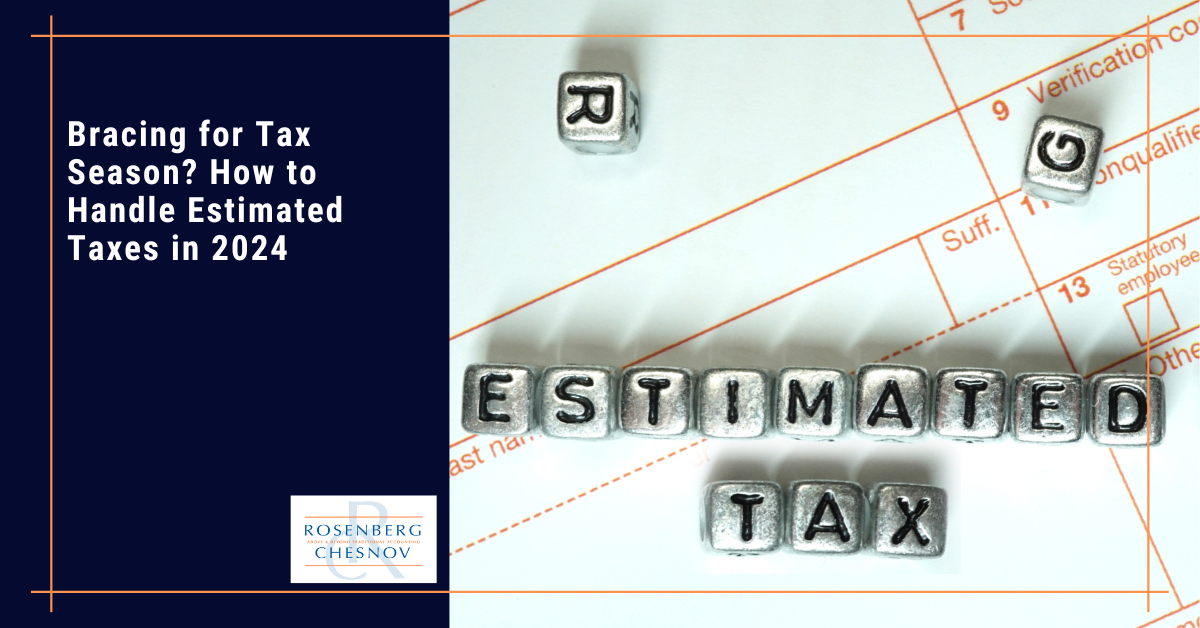Who must pay estimated taxes in 2024?
Estimated taxes are periodic payments made to the IRS by certain individuals and businesses on income not subject to withholding, including income from self-employment, interest, dividends, rent, alimony, and gains from the sale of assets, among other sources.
Put another way: All taxpayers must pay taxes throughout the year and then file their returns to get any money back they may be owed. If you are an employee, your employer typically withholds that income from your pay (tax may also be withheld from certain other income such as IRAs, pensions, bonuses, commissions, and gambling winnings).
However, some taxpayers, like self-employed individuals, small business owners, and those who receive substantial income outside of wage withholding, typically do not have those taxes withheld — so they need to handle it by making estimated tax payments.
You may be required to pay an estimated tax if you are:
- Self-employed: As a freelancer, independent contractor, or sole proprietor. Since you are effectively both the employee and employer, no taxes are withheld from payments received.
- A partner in a partnership: Partnerships don’t withhold taxes on partner distribution payments, necessitating estimated tax for partners.
- Business owner of an LLC, S-corp, or C-corp: Owners receiving business income without payroll withholding may need estimated payments.
- Earning non-payroll income: If you make extra income from side jobs, interest, dividends, investments, prizes, or rental real estate, you’ll likely owe estimated tax.
- A retiree with investment income: Retirement income sources like pensions, IRAs, annuities, interest, and dividends generally don’t have tax withheld.
- Receiving alimony: Since federal tax rules no longer allow the deduction of alimony paid, recipients must pay income tax.
Essentially, estimated taxes apply any time you receive income, not subject to withholding exceeding $1,000 in tax liability.
This encompasses a broad range of everyday situations for those earning non-payroll income — and even if you have taxes withheld from W-2 wages, non-wage income may trigger estimated tax requirements.
Who does not have to pay estimated taxes?
If you receive W-2 wages, boosting your payroll tax withholding can eliminate estimated quarterly taxes. Simply file an updated W-4 with your employer, using line 4c to elect extra withholding amounts.
You also bypass estimated tax if last year all three of the following were true of you:
- You had no tax liability.
- You were a U.S. citizen or resident for the whole year.
- Your prior tax year covered a 12-month period. You had no tax liability for the prior year if your total tax was zero or you did not have to file an income tax return.
When are the federal estimated tax due dates for 2023?
Estimated tax payments are generally made quarterly. In 2023, the first three quarterly deadlines were:
- Payment #1 – April 18, 2023
- Payment #2 – June 15, 2023
- Payment #3 – September 15, 2023
Hopefully, if you are subject to estimated taxes, you have already made your payments on or before each of those deadlines.
The fourth and final deadline for the 2023 tax year is January 16th, 2024.
When are the federal estimated tax due dates for 2024?
In 2024, the quarterly deadlines you need to know are as follows:
- Payment #1 – April 15th, 2024
- Payment #2 – June 17th, 2024
- Payment #3 – September 16th, 2024
- Payment #4 – January 15th, 2025
The difference in dates is due to weekends and holidays — typically, the deadlines fall on the 15th, but they generally are shifted to the closest following business day.
What happens if you miss your quarterly estimated tax payments?
If you miss a quarterly estimated tax payment, the IRS may impose penalties and interest on the amount of underpayment. Interest accrues from the due date of the payment until the date of payment.
The penalty is calculated based on a percentage of the underpayment, which can change quarterly, and it’s compounded daily. (The IRS uses Form 2210 to determine the amount of underpayment and the penalty).
However, if you promptly make up the missed payment, the penalty amount may be reduced. Additionally, overpaying in later quarters can offset the underpayment from earlier in the year.
Furthermore, there is also a “safe harbor” rule that can protect you from penalties if you pay either 90% of the current year’s tax or 100% of the prior year’s tax (110% if your adjusted gross income is above a certain threshold).
In certain circumstances, such as with unusual events or disasters, the IRS may offer relief from penalties. If you can show reasonable cause for the underpayment and not willful neglect, the IRS may waive penalties entirely. (Don’t count on that, though!)
It’s important to address missed payments as soon as possible to minimize penalties and interest. If you’re unsure of how to proceed, consider consulting with a tax professional for guidance specific to your situation.
How do you calculate and file your estimated taxes for 2023?
Determining how much you’ll owe in taxes for any given year is critical for accurately making your four estimated payments to the IRS.
Follow these steps when planning your prepaid tax obligations:
- Estimate Your Taxable Income for 2023: Add up your expected income for the year, including self-employment income, interest, dividends, rent, and any other taxable income not subject to withholding.
- Estimate Deductions and Credits: Subtract any tax deductions you plan to take, such as business expenses, student loan interest, or standard/itemized deductions. Also, consider any tax credits you may be eligible for.
- Calculate Your Tax Liability: Use the estimated taxable income to calculate your tax liability for the year. You can use the tax rates and brackets for 2023 or the IRS’s Estimated Tax Worksheet found in Form 1040-ES.
- Consider Withholding: If you have any taxes withheld from other income (like wages from an employer), subtract that amount from your calculated tax liability
- Determine Estimated Tax Payments: Divide the remaining tax liability by four to determine how much you should pay for each quarterly estimated tax payment.
- Make Payments: You can pay your estimated taxes using the IRS Direct Pay system online, by phone, or by mailing a check or money order with a completed Form 1040-ES voucher.
If your income varies throughout the year, you may need to recalculate your estimated taxes before each payment due date. If you find this process overwhelming, using tax software or consulting with a tax professional might be beneficial.
How do you pay your estimated taxes?
Paying your estimated taxes can be done through several methods:
- IRS Direct Pay: Use the IRS Direct Pay service to pay online directly from a checking or savings account for free.
- Electronic Federal Tax Payment System (EFTPS): Enroll in the EFTPS to pay your taxes online or by phone. This system is also free and allows you to schedule payments in advance.
- Credit or Debit Card: Pay online, by phone, or with a mobile device through one of the IRS-approved payment processors. Note that the processor might charge a convenience fee.
- Mobile App: Use the IRS2Go app to make payments via Direct Pay or by debit/credit card.
- Check or Money Order: Send a check or money order by mail along with a payment voucher from Form 1040-ES. Make sure checks are payable to the “United States Treasury” and include your Social Security number, phone number, and the tax period for the payment.
- Electronic Funds Withdrawal: When using tax preparation software to file your taxes, you can often opt to have your estimated taxes withdrawn directly from your bank account.
- Wire Transfer: You can wire your estimated tax payments using a same-day tax payment service available through your bank.
Always keep records of your payments, including amounts and dates, in case you need to reference them later or prove payment to the IRS. Submitting payments by the due dates is essential to avoid potential penalties for late payment.
Bottom line: Receiving income not subject to withholding does not exempt you from tax obligations.
Reach out if you need assistance. Our team of experts stands ready to help you understand your requirements and optimize your obligations.
Would you like some help?
If you are a client and would like to book a consultation, call us at +1 (212) 382-3939 or contact us here to set up a time.
If you aren’t a client, why not? We can take care of your accounting, bookkeeping, tax, and CFO needs so that you don’t have to worry about any of them. Interested? Contact us here to set up a no-obligation consultation.
Stay informed
Interested in receiving updates in your mailbox? Check out our newsletter, full of information you can use. It comes out once every two weeks, and you can register for it below.





